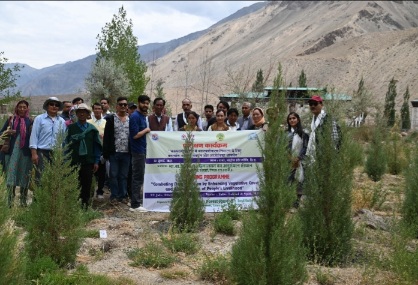Training Programme on Combating Desertification Held in Tabo, Lahaul & Spiti. Charma and Juniper pose challenge to scientists.
SHIMLA/ TABO: Juniper and Charma, the high altitude species, promise a greening of the arid cold desert of Spiti as HFRI scientists have broken the high dormant cycle of Juniper, a species found to be least naturally propagating in high altitude areas.
But it doesn't end here. The scientists face challenge to propagate Charma in more commercial avatar so that it's berries become source of sustainable livelihoods to motivate the tribals to grow more and more.
In this light, the ICFRE-Himalayan Forest Research Institute (HFRI), Shimla, organized a one-day training programme on "Combating Desertification by Enhancing Vegetative Cover and Augmentation of People’s Livelihood" for farmers and villagers in Tabo, Lahaul & Spiti on July 22, 2024.
The programme saw participation from 35 farmers from Tabo and Mane Gram Panchayats.
Dr. RK Verma, Training Coordinator and Scientist-G at HFRI, emphasized the importance of increasing green cover in arid regions with the help of local communities.
Dr. Verma highlighted species like Willow, Poplar, and Charma for their benefits in natural resource management.
Charma, in particular, not only helps conserve the fragile soil found in Lahaul-Spiti and upper Kinnaur but also produces berries rich in iron and other micronutrients, offering farmers a potential alternative source of income if fully utilized.
Leh berries is a brand name standardized by DRDO. But Spiti has yet tap potential of Charma that produce the berries.
However, scientists face the challenge of propagating new strands of Charma for greater yields and broader green cover, requiring collaboration with government and Panchayati Raj institutions.
Dr. Bandana Dhiman from Krishi Vigyan Kendra (KVK), Tabo, gave an informative presentation on the medicinal plants of Spiti Valley.
She pointed out the economic potential of cultivating, harvesting, and marketing these high-value medicinal species.
Scientist Sh. Pitamber Singh Negi discussed the significance of Juniper (Shukpa) in social, religious, and ecological contexts.
Negi shared his research on breaking seed dormancy in Juniper and encouraged participants to plant this species to benefit the community and conserve the fragile environment.
Senior Technical Officer Sh. Dushyant Kumar provided insights into nursery practices for indigenous cold desert species, stressing the need for tailored efforts to increase vegetative cover in the unique cold-desert ecology.
Participants visited demonstration plantation areas at Field Research Station, Tabo, and Sushana, observing the growth performance of various species like Salix, Poplar, Juniper, Colutea, and Eleagnus.
The programme concluded with a plenary session where participants and resource persons discussed various ecological issues.
The farmers appreciated the training and shared positive feedback.







